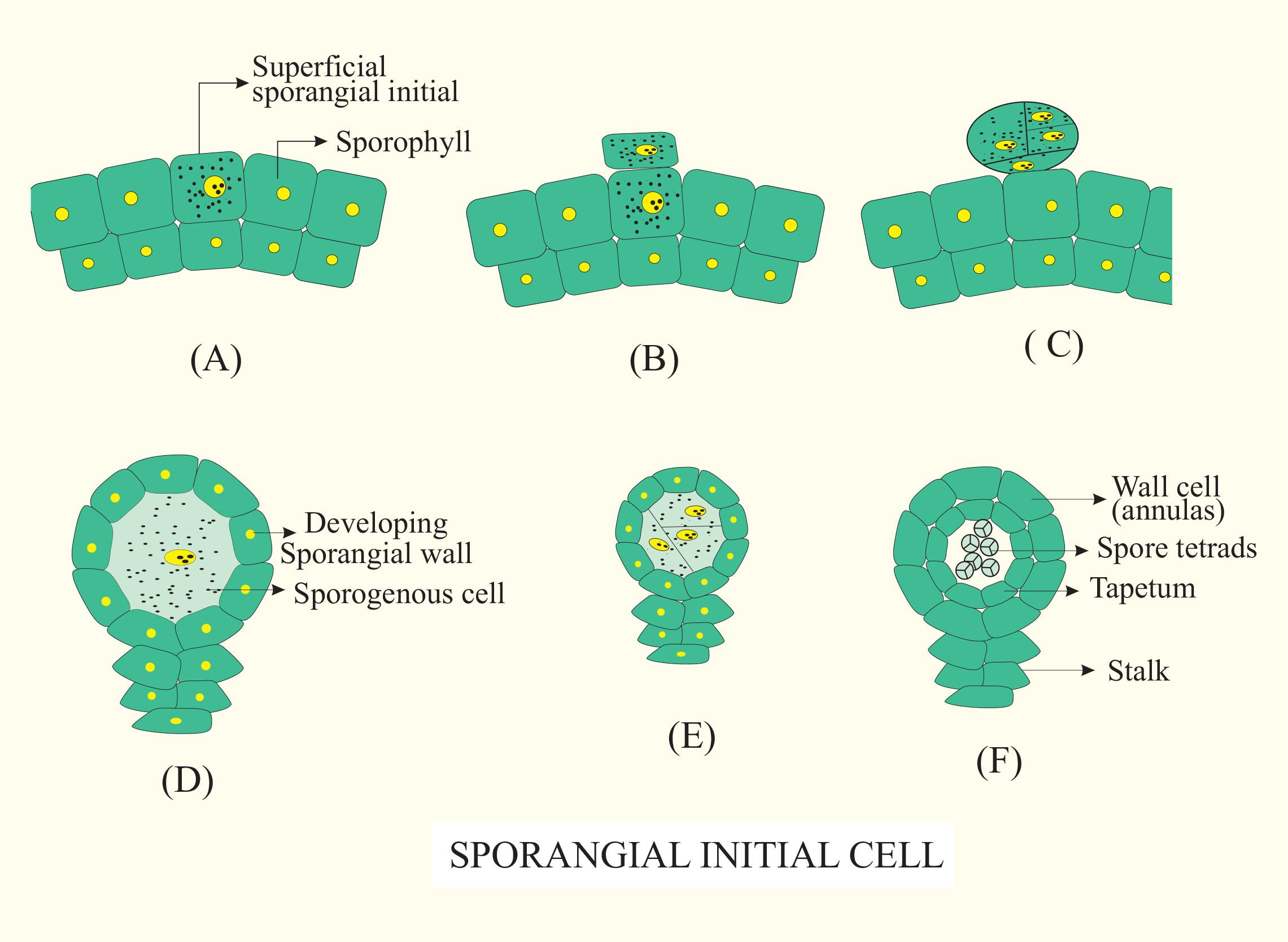
Eusporangiate fern is produced from
(A)Group of sporangial initial cell
(B)Single initial cell
(C)Epidermal cells
(D)Hypodermal cell
Answer
477.3k+ views
1 likes
Hint: As the word suggests, the eu prefix means true. The eusporangiate development is true development from a certain community of cells. The cells which are adjacent to these cells also contribute to the formation of the wall or stack of the sporangium.
Complete answer:
The eusporangiate sporangia develop from a group of sporangial initial cells. They divide into two components: the outer and the inner component. The outer cells give rise to the cell wall whereas the sporogenous tissues arise from the inner cell wall.
Additional Information: Ferns differ from the mosses as they are vascular which means they have specialized tissues that conduct water and nutrients and in having life cycles in which the sporophyte is the dominant phase. Ferns have very complex leaves which are known as megaphylls, which are more complex than the microphylls of clubmosses. Most ferns are leptosporangiate ferns. They also produce coiled fiddleheads that uncoil and expand into fronds
Some characteristics of the division Pteridophyta are:
These are flowerless, seedless, spore-producing vascular plants that have successfully invaded the land.
-The plants that come under this division are sporophytes. Their reproduction is asexual by the formation of spores in sporangia.
-The main body of pteridophytes is differentiated into true roots, stem, and true leaves.
-The vascular tissues are present in these and are organized in definite groups.
-The leptosporangiate type of sporangium arises from a single superficial initial. The inner cell forms a stalk here while the cell present on the outside gives rise to the sporogenous tissue.
So, the correct answer is ‘Group of the sporangial initial cell’.
Note: Pteridophytes are also known as vascular cryptogams.
-The fertilization in pteridophytes is zooidogamy (affected by water).
-The term pteridophyte is taken from greek meaning, Pteron= father/fern; phyton= plants.
-Late paleozoic age is known as the age of pteridophytes.

Complete answer:
The eusporangiate sporangia develop from a group of sporangial initial cells. They divide into two components: the outer and the inner component. The outer cells give rise to the cell wall whereas the sporogenous tissues arise from the inner cell wall.
Additional Information: Ferns differ from the mosses as they are vascular which means they have specialized tissues that conduct water and nutrients and in having life cycles in which the sporophyte is the dominant phase. Ferns have very complex leaves which are known as megaphylls, which are more complex than the microphylls of clubmosses. Most ferns are leptosporangiate ferns. They also produce coiled fiddleheads that uncoil and expand into fronds
Some characteristics of the division Pteridophyta are:
These are flowerless, seedless, spore-producing vascular plants that have successfully invaded the land.
-The plants that come under this division are sporophytes. Their reproduction is asexual by the formation of spores in sporangia.
-The main body of pteridophytes is differentiated into true roots, stem, and true leaves.
-The vascular tissues are present in these and are organized in definite groups.
-The leptosporangiate type of sporangium arises from a single superficial initial. The inner cell forms a stalk here while the cell present on the outside gives rise to the sporogenous tissue.
So, the correct answer is ‘Group of the sporangial initial cell’.
Note: Pteridophytes are also known as vascular cryptogams.
-The fertilization in pteridophytes is zooidogamy (affected by water).
-The term pteridophyte is taken from greek meaning, Pteron= father/fern; phyton= plants.
-Late paleozoic age is known as the age of pteridophytes.

Latest Vedantu courses for you
Grade 6 | CBSE | SCHOOL | English
Vedantu 6 Pro Course (2025-26)
School Full course for CBSE students
₹45,300 per year
Recently Updated Pages
Master Class 11 Economics: Engaging Questions & Answers for Success

Master Class 11 Business Studies: Engaging Questions & Answers for Success

Master Class 11 Accountancy: Engaging Questions & Answers for Success

Master Class 11 English: Engaging Questions & Answers for Success

Master Class 11 Computer Science: Engaging Questions & Answers for Success

Master Class 11 Maths: Engaging Questions & Answers for Success

Trending doubts
State and prove Bernoullis theorem class 11 physics CBSE

1 ton equals to A 100 kg B 1000 kg C 10 kg D 10000 class 11 physics CBSE

State the laws of reflection of light

One Metric ton is equal to kg A 10000 B 1000 C 100 class 11 physics CBSE

1 Quintal is equal to a 110 kg b 10 kg c 100kg d 1000 class 11 physics CBSE

Difference Between Prokaryotic Cells and Eukaryotic Cells




